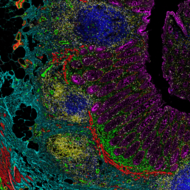What does high-parameter cytometry really mean?
High-parameter cytometry sounds simple enough – indicating more markers are used per assay – but in reality, different high-parameter assays depend on the innate capabilities of a technology.

Multicolor flow cytometry, spectral cytometry and cytometry powered by time-of-flight (used in CyTOF® systems) all incorporate the term ‘high-parameter.’ High-parameter cytometry sounds simple enough – indicating more markers are used per assay – but in reality, different high-parameter assays might not always live up to your expectations. In other words, it’s important to look at the innate capabilities of a technology first.
The visible spectrum of fluorescence
Conventional flow cytometry typically contains 1-4 lasers and up to 10 detectors that allow for the potential detection of up to 28 parameters, while only 10 can simultaneously be detected on one cell. Spectral flow cytometry can have up to 5 lasers and 64 fluorescent detectors to measure the full spectrum emission of every fluorophore. This allows the possible expansion of phenotyping panels beyond 40 fluorescent parameters (not present concurrently on the same cells), yet is limited by the availability of fluorophores and antibody-fluorophore conjugates that are distinct enough to be accurately unmixed on the system.
Since the technology is based on fluorescent markers, there is a significant challenge in balancing co-expression, signal overlap and fluorophore brightness, all of which influence the number of parameters that can be measured. Depending on the level of protein expression targeted by each antibody, the fluorophore type must be matched to a protein with an expression level such that no one fluorophore will be too bright to cover other signals or so dim as to go undetected. In an experimental or clinical/translational setting, expression of key markers such as for checkpoint or signaling molecules can be quite unpredictable, adding to the complexity of panel design. These issues also necessitate additional validation and staining controls, adding more steps and tubes of sample for every experiment. As one would surmise, the more fluorophores used, the more antibody management needed, and the more difficult it is to build or modify larger panels.
More capabilities with metals
CyTOF technology is based on the use of heavy-metal tags detected and separated by mass. This powerful yet simple single-detector system with a straightforward signal path from ionization to detection results in negligible background and minimal signal overlap. Furthermore, CyTOF is built with the capability to use 135 channels.
Because CyTOF signals do not rely on fluorescence and thus are extremely discrete, the result is negligible signal overlap with no need for additional color validations and controls. CyTOF technology facilitates the use of more markers that can be detected simultaneously in a single cell and far less sample in a single panel. This approach empowers the user to match metals to antibodies without worrying about color combinations and allows addition or removal of markers with ease. What these features translate to is the ability to quickly build larger panels, being inherently high parameter.
What to consider
Fluorescence can only go so far, no matter how many channels you have. Since colors primarily fall within the visible spectrum, between wavelengths of about 380–700 nanometers, there is a finite number of fluorophores possible. CyTOF has more potential in comparison since there are more choices of metals that can be used and no colors to manage.
A primary advantage of using high-parameter tools is that it allows a look at everything at once, making the most efficient use of limited samples and providing an unbiased view of the underlying biology. Whether you want to see cell type by surface markers or activation status by intracellular markers, CyTOF panels empower bigger questions to be asked and solutions realized. This equates to true high-parameter analysis, where panel design is achievable – whether you want to look at 20 markers or more than 50. This is realized in the over 2,000 publications and more than 200 clinical trials that rely on the high-parameter benefits of CyTOF technology.
In fact, Standard BioTools™ offers preconfigured panels to make this even easier. Multiple 45-plus marker panels can be quickly built for immunophenotyping by using the Maxpar® Direct™ Immune Profiling Assay™ as a backbone, dropping in various combinations of 9 Expansion Panels then filling in any gaps with additional antibodies of your choosing from the Maxpar catalog. An example is given in an Application Note showing how you can create a 47-marker panel for identifying antigen-specific T cells and their activation status. In addition to being high parameter, this CyTOF panel enables a look at intracellular markers for a tangible understanding of response and behavior.
So, if you are considering conducting high-parameter studies, just make sure you are using technology that can do what you expect.
No CyTOF? No problem!
Get in touch with us and we can put you in contact with one of our Field Application Specialists. They can help you translate your fluorescence panel to a CyTOF panel and find a CyTOF service provider near you.
Check out other blog posts
Familiar with IHC?

Then you already know IMC.
If IHC is your comfort level, IMC lets you maintain that confidence in your research while moving it forward for insights you didn’t see coming.
Invest in Automation to Save Money in the Long Run
Where should managers put their focus to ensure their labs run smoothly? Learn about a new metric that can help improve lab efficiencies and cost savings for years to come.
To automate or not to automate?
Considerations for when to automate, from common drivers to what you really should be thinking about.
Unless explicitly and expressly stated otherwise, all products are provided for Research Use Only, not for use in diagnostic procedures. Find more information here.


